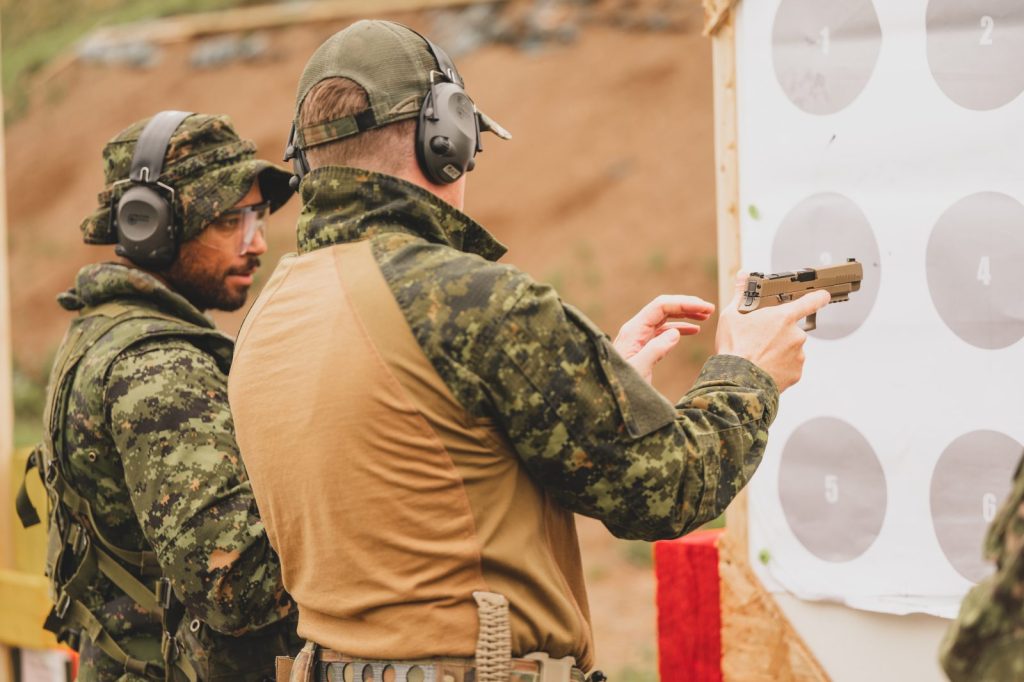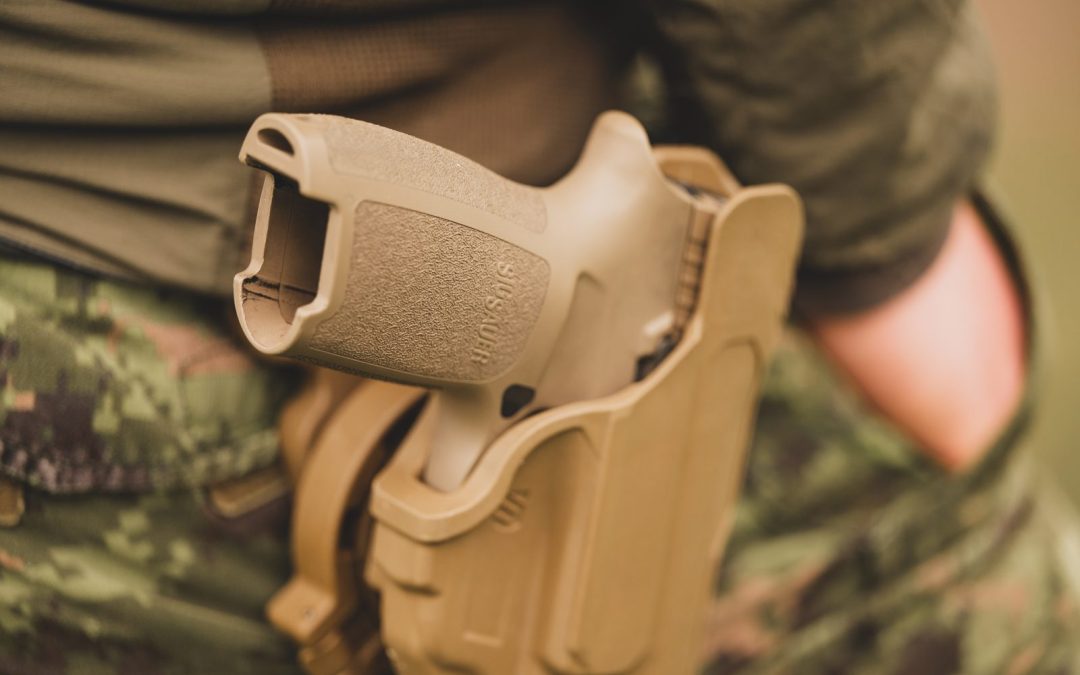by Ken Pole
Considering firearms controls and setting aside the law enforcement community, the first time most Canadians encounter pistols is likely when they join the military. The Army is the most common vector since its approximately 44,000 Regular and Reserve personnel account for two-thirds of the Canadian Armed Forces (CAF) overall.
Training personnel on pistols, especially new models that break with tradition, can be a challenge. That’s currently the case as the Army introduces its new SIG Sauer P320, officially designated the C22 Modular Full Frame Pistol (MFFP).
Selected in September 2022 — five years after the U.S. Army — it replaces the vintage 9mm Browning Hi-Power that the Army began using in January 1944.
Conceived by an American, John Browning, and refined at Fabrique Nationale in Belgium, the Hi-Power — named for its large magazine capacity at the time — is no longer supportable. Until their retirement from service, the Army had to plunder unusable Brownings for parts to keep others operational.
But the advent of the C22 begs a question: who trains the trainers on the new pistol? Even experienced infantry do not simply pick one up and start shooting. That’s where Warrant Officer Roy Ritch comes into the picture.
Posted to the 1st Battalion, The Royal Canadian Regiment, in Petawawa for most of his career, Ritch is a Master Sniper who deployed twice to Afghanistan and is now assigned to the Directorate of Land Requirements (DLR).
“My main role at DLR is to provide support to the small arms project team,” he explained in an interview with Canadian Army Today. His involvement with the C22 began with the precision testing of the pistol in late July 2022, followed in February by assembling a team of CAF personnel, including instructors from the Combat Training Centre in Gagetown — many of them Afghanistan veterans — for an instructor training program.
They gathered at the SIG SAUER Academy in Epping, New Hampshire, a 25-minute drive from the company’s headquarters in Newington.
The academy cycles through tens of thousands of shooters on courses every year on its picturesque 57-hectare site, replete with state-of-the art indoor and outdoor ranges, as well as tactical training areas, urban environments, a shoot house, a maritime training area, and a force-on-force village layout.
In addition to the Canadian Army and other military customers, the academy trains special forces operators, police and security personnel, as well as sports shooters and other rigorously vetted civilians.
“All of our initial training was in the indoor range facilities,” Ritch said. “However, we could build customized ranges with barricades and obstacles for more dynamic training.” Their two week-long session was intense, beginning with quick lessons on how to dismantle and reassemble the new pistol and how it operates, immediately followed by live-fire range practices.

Members of the C22 Pistol Train the Trainer Course at the Combat Training Centre in Gagetown in June 2023. Photo: MCpl Samuel Martell
The course focus was split between tactical pistol training — the draw sequence utilizing the new modular Blackhawk T-Series L2D holster issued with each pistol; how to remedy stoppages; multiple target engagements; shooting on the move; use of cover; and no light/low light conditions — with how to become more proficient instructors. At its most basic, they learned different grip methods such as thumb placement and grip pressure to understand what would work best for individual soldiers.
Once the Canadian contingent returned home, “the Advanced Small Arms Instructor Cell began developing a training package specific to Army requirements,” said Ritch. “It combined everything we had before in the CAF with updated practices and techniques we learned at the academy. When these are applied correctly, pistol marksmanship will undoubtedly improve.”
As the new syllabus was developed, the Canadian Army Doctrine and Training Centre (CADTC) weighed in on how to best allocate the number of student positions across the five divisions. It’s a Goldilocks approach—not too many, not too few — to ensure that as personnel are introduced to the new pistol, an operational core is preserved within each unit.
Pistols are close-quarters weapons, but with the newer technologies and the C22 having more than twice the precision of the Browning, infantry can now be trained at distances up to 50 metres with the new supplemental range practices.
Feedback within the Army so far has been positive, particularly that the C22 is truly ambidextrous, unlike older Brownings. Like other elements of the new firearm, that potentially enhances troops’ effectiveness in urban operations.


This is the civilian version of P320??
C22 is the miltary designation for the P320
if this is the weapon sig sauer that the was only issued to the Military Police and the intel personnel. my question is does it use 9mm ball or 9mm hollow point. The reason i ask is if you are using 9MM Ball ammo then you will have many stoppages, if its the 9mm hollow point? is that not against the Geneva Convention?